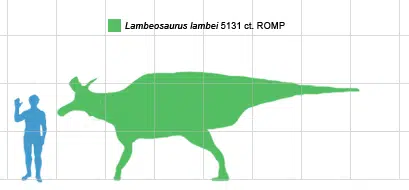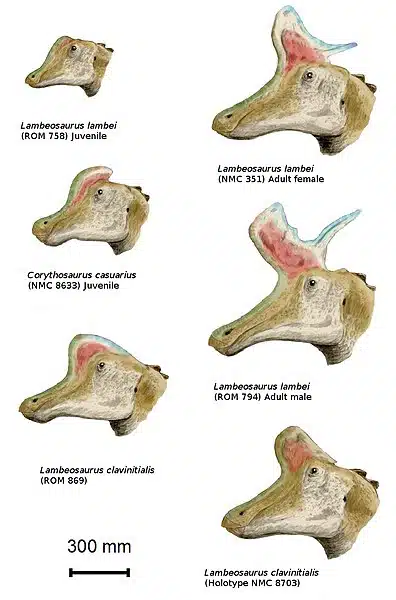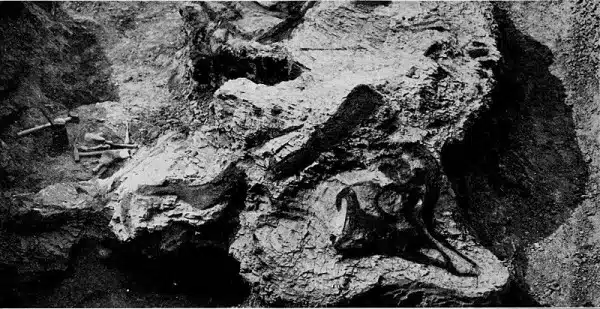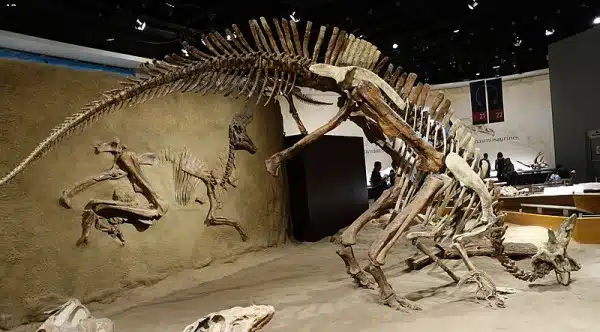Lambeosaurus, meaning “Lambe’s Lizard,” pays homage to Lawrence Lambe, the paleontologist who first described the species. It belongs to the Ornithopod group and the Hadrosaurid family. Its diet, purely herbivorous, reflects the rich vegetation of its time. Living between 83.5 and 72.1 million years ago (MYA), this dinosaur witnessed significant changes in the Earth’s landscapes and ecosystems.
Lambeosaurus Key Facts
| Keyword | Fact |
|---|---|
| Pronunciation | lam-BEE-oh-SORE-us |
| Meaning of name | Lambe’s Lizard |
| Group | Ornithopod |
| Type Species | Lambeosaurus lambei (syn. Tetragonosaurus praeceps) |
| Other Species | Didanodon altidens, Lambeosaurus clavinitialis (syn. Corythosaurus frontalis), Lambeosaurus magnicristatus |
| Diet | Herbivore |
| When it Lived | 83.5 to 72.1 MYA |
| Period | Late Cretaceous |
| Epoch | Late/Upper Campanian to the top of the Campanian |
| Length | 23.0 to 25.0 feet |
| Height | Approximately 7.0 feet |
| Weight | 2.8 to 3.6 tons |
| Mobility | Moved on two legs |
| First Discovery | 1910 by several Paleontologists |
| Described by | 1902 by Lawrence Lambe |
| Holotype | GSC 419 |
| Location of first find | Dinosaur Park Formation, Alberta |
Lambeosaurus Origins, Taxonomy and Timeline
This herbivorous dinosaur is a captivating relic of the Late Cretaceous Period that offers a window into the evolutionary intricacies of the dinosaur era. It is named in honor of Lawrence Lambe, with a name that combines ‘Lambe’ with ‘sauros,’ the Greek word for lizard or reptile.
In the grand scheme of dinosaur taxonomy, Lambeosaurus is categorized within the Ornithopod group under the Hadrosaurid family. This classification underscores its evolutionary lineage and relationship with other similar dinosaurs.

Tracing its existence back to the Late Cretaceous Period, specifically from the Late Campanian to the Campanian Epoch, it lived approximately between 83.5 and 72.1 million years ago. This era was a time of significant environmental and ecological changes, providing the backdrop for the evolution and life of Lambeosaurus.
Discovery & Fossil Evidence
Our story begins in 1902 with Lawrence Lambe, who initially named hadrosaurid limb material and bones from Alberta as Trachodon marginatus. This early classification soon encountered complexities. Henry Fairfield Osborn suggested these could belong to a new genus, “Didanodon,” a notion that didn’t gain much traction.
Adding to the complexity of Lambeosaurus’ history is its subspecies, L. magnicristatus, identified by C.M. Sternberg in 1935. Known from only two skull specimens, this subspecies is a crucial piece of the Lambeosaurus puzzle. Unfortunately, much of the articulated skeleton of the type specimen of L. magnicristatus has been lost, leaving gaps in our full understanding of this particular subspecies. Despite this, the discovery of L. magnicristatus offers valuable insights into the diversity and adaptability within the Lambeosaurus genus.
Taxonomic Complications
In the 1910s, better-preserved Hadrosaurid remains emerged from Alberta’s Dinosaur Park Formation. Lambe reassessed his finds and coined the genus Stephanosaurus for the species in 1914. However, the connection between these skulls and the earlier material was not solid. In 1923, William Parks introduced Lambeosaurus lambei, honoring Lambe 4 years after his death, and established it as the type genus of the new subfamily Lambeosaurinae.
The plot thickens with the discovery of juvenile Lambeosaurus remains, initially mistaken as adult remains of a distinct lineage of Cheneosaurinae. In 1920, William Diller Matthew briefly mentioned a skeleton as Procheneosaurus, a name later contested by Parks who proposed Tetragonosaurus with two species. Charles M. Sternberg added another species in 1935. However, the International Commission of Zoological Nomenclature ultimately favored Procheneosaurus. By 1942, several species were tentatively transferred to Procheneosaurus, a classification generally accepted until 1975.
Peter Dodson then questioned the plethora of Lambeosaurine species in a confined geological and geographical scope. His morphometric study suggested that many species were actually juveniles or different sexes of Lambeosaurus. He proposed that L. clavinitialis was likely the female of L. lambei, with Corythosaurus frontalis and Procheneosaurus praeceps as its juveniles. L. magnicristatus, however, was distinct enough to be its own species. This model simplified the Lambeosaurus lineage and is widely accepted today, recognizing primarily two species with a third occasionally acknowledged.
- Profiles of various specimens, once assigned to their own species, now interpreted as different growth stages and sexes of L. lambei
- Mounted L. lambei skeleton, Royal Ontario Museum
- L. lambei skull being excavated in Alberta, Canada
- Lambeosaurus skeletal mount. On display at the Royal Tyrrell Museum, Alberta.
- Skull of Lambeosaurus lambei specimen TMP 1982.038.0001.
- Skull of an adult, AMNH
Lambeosaurus Size and Description
This dinosaur is easily recognized by its most distinctive feature–its crest. The many shapes and sizes of Lambeosaurus once had paleontologists believing it was several more species than it truly is. Let’s take a closer look at its variability as well as what features make it unique in the world of dinosaurs.
Size and Weight of Type Species

In terms of size, adult Lambeosaurus specimens were formidable creatures. They have been estimated to reach lengths of approximately 23.0 to 25.0 feet and weigh between 2.8 to 3.6 tons. This size places them among the larger members of the Hadrosaurid family. These conclusions were reached by Gregory Paul in 2016.
The Dinosaur in Detail
One of the most striking features of Lambeosaurus is its unique crest, differing significantly between the two well-known species, L. lambei and L. magnicristatus. In L. lambei, the crest resembled a hatchet with a forward-projecting “blade” and a solid bony “handle” extending over the skull’s back. This crest, evolving into its full form as the dinosaur approached adulthood, consisted of a thin upper “coxcomb” and a lower portion housing the nasal passages. In contrast, L. magnicristatus boasted a more exaggerated, pompadour-like crest, with a reduced “handle” and an expanded “blade.”
Beyond the crest, Lambeosaurus shared common Hadrosaurid traits. It could move on both two legs and all fours. This movement was supported by a long, stiff tail and hands equipped for support and manipulation. The footprints of related species suggest a versatile locomotion, capable of both bipedal and quadrupedal movement. Its four-fingered hands had the three inner fingers grouped together. These fingers had hoof-like ends and were used mostly for support during locomotion. The last finger could move freely and could be used for manipulation.
Fossil impressions of its skin have been found that show it was covered in uniform, polygonal scutes. These scutes were distributed randomly across the neck, torso, and tail, and provide a glimpse into the texture and protective features of its skin. Similar scalation patterns have been observed in both L. lambei and L. magnicristatus, indicating a shared characteristic within the genus.
Interesting Points about Lambeosaurus
- Its unique head crest was potentially used for communication or display.
- Its role as a large herbivore meant it helped to shape the Late Cretaceous vegetation.
- This was an adaptable species of dinosaur, as evidenced by its widespread fossils.
- Its discovery was significant in understanding the dynamic taxonomy of the Hadrosaurid family.
- There are ongoing debates and studies surrounding its exact size and weight.
Lambeosaurus in its Natural Habitat
This North American dinosaur thrived in a world vastly different from ours. The Late Cretaceous Period was characterized by diverse and lush vegetation, providing ample food for this herbivore. The climate was likely warmer with varied geographical features shaping its habitat as the Cretaceous Interior Seaway closed and North America began to resemble the continent we know today.
As an herbivore, this dinosaur played a crucial role in its ecosystem. Its diet consisted of the abundant plant life of its time and its locomotion suggests it could traverse various terrains. Its beak could crop plants low to the ground. Standing on its back two legs, it would have been able to reach for higher vegetation using its forefeet or beak. It was able to feed up to 13 feet off the ground.
Whether it was a solitary creature or moved in herds remains a topic of interest, potentially offering insights into its survival strategies. Its impact on its environment could have been significant. As a large herbivore, it likely influenced the vegetation patterns and possibly the overall landscape. Understanding its role in the ecosystem provides a window into the dynamics of the Late Cretaceous Period.
Contemporary Dinosaurs
Lambeosaurus, a great duck-billed dinosaur, roamed what is today Canada’s western province of Alberta. This gentle giant, with its striking crest, would be ambling through the ancient forests. Its life was a constant dance of competition with fascinating contemporaries. Among them was Parasaurolophus, another crested charmer, slightly smaller but just as impressive. These two possibly munched on the same ferns and conifers and might have shared a friendly, if somewhat competitive, relationship over the best salad bars nature had to offer.

Enter Hypacrosaurus, roughly the same size but perhaps a bit more robust. These two could have been rivals that fought for territory. Imagine the thunderous sound of their heavy feet as they moved through the forest, a prehistoric drama unfolding with each step.
Not all neighbors were competitors, though. Take Hadrosaurus, a smaller cousin in the Hadrosaur family. This smaller, less ornate dinosaur likely looked up to Lambeosaurus, both figuratively and literally. They could have moved in herds–a prehistoric example of safety in numbers when predators lurked nearby.
Ankylosaurus presented a stark contrast to our Lambeosaurus. This tank-like dinosaur was armored and sported a massive club tail. While Lambeosaurus used its size and speed for defense, Ankylosaurus was a walking fortress. Their interactions, though not aggressive, must have been like a meeting of two different philosophies of survival – speed and agility versus brute strength and armor.
This mixture of similar relatives and radically different dinosaurs showcases the diversity of the landscape and Lambeosaurus’ adaptability and versatility. It is not easy for a dinosaur to compete with so many species living a similar lifestyle, but Lambeosaurus was able to persist nonetheless.
Frequently Asked Questions
It lived during the Late Cretaceous Period approximately 83.5 to 72.1 million years ago.
Lambeosaurus was an herbivore, feeding on the lush vegetation of its time. Its great size allowed it to feed up to 13 feet off the ground.
It was capable of moving around on both two legs or four legs. It forefeet were adapted to both supporting its weight and manipulating objects.
The name “Lambeosaurus” honors Lawrence Lambe, the paleontologist who first described the species.
The first fossil was discovered in the Dinosaur Park Formation in Alberta in 1910.
Debates often focus on its exact size and weight, as well as the function of its potential head crest.
Sources
The information in this article is based on various sources, drawing on scientific research, fossil evidence, and expert analysis. The aim is to provide a comprehensive and accurate overview of Lambeosaurus. However, please be aware that our understanding of dinosaurs and their world is constantly evolving as new discoveries are made.
- https://archive.org/details/onvertebrataofmi00osbo
- https://archive.org/details/cbarchive_34888_onanewgenusandspeciesofcarnivo9999
- https://www.researchgate.net/publication/266459570_The_first_lambeosaurin_Dinosauria_Hadrosauridae_Lambeosaurinae_from_the_Upper_Cretaceous_Ojo_Alamo_Formation_Naashoibito_Member_San_Juan_Basin_New_Mexico
This article was last fact-checked: Joey Arboleda, 12-07-2023
Featured Image Credit: Connor Ashbridge, CC BY-SA 4.0, via Wikimedia Commons






